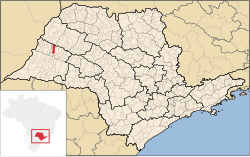Pacaembu | |
|---|---|
 Location in São Paulo state | |
| Coordinates: 21°33′44″S 51°15′38″W / 21.56222°S 51.26056°W | |
| Country | Brazil |
| Region | Southeast |
| State | São Paulo |
| Area | |
| • Total | 339 km2 (131 sq mi) |
| Population (2020 [1]) | |
| • Total | 14,263 |
| • Density | 42/km2 (110/sq mi) |
| Time zone | UTC−3 (BRT) |
Pacaembu (Portuguese pronunciation: [pakaẽˈbu]) is a municipality in the state of São Paulo in Brazil. The population is 14,263 (2020 est.) in an area of 339 km².[2] The elevation is 415 m.
History[edit]
The municipality was created by state law in 1948.[3]

Media[edit]
In telecommunications, the city was served by Telecomunicações de São Paulo.[4] In July 1998, this company was acquired by Telefónica, which adopted the Vivo brand in 2012. The company is currently an operator of cell phones, fixed lines, internet (fiber optics/4G) and television (satellite and cable).[5]
Religion[edit]
Christianity is present in the city as follows:
Catholic Church[edit]
The Catholic church in the municipality is part of the Roman Catholic Diocese of Marília.[6]
Protestant Church[edit]
The most diverse evangelical beliefs are present in the city, mainly Pentecostal, including the Assemblies of God in Brazil (the largest evangelical church in the country),[7][8] Christian Congregation in Brazil,[9] among others. These denominations are growing more and more throughout Brazil.
References[edit]
- ^ IBGE 2020
- ^ Instituto Brasileiro de Geografia e Estatística
- ^ "Municípios Paulistas". www.al.sp.gov.br (in Portuguese). Retrieved 2024-06-26.
- ^ "Creation of Telesp - April 12, 1973". www.imprensaoficial.com.br (in Portuguese). Retrieved 2024-06-14.
- ^ "Our History - Telefônica RI". Telefônica. Retrieved 2024-06-14.
- ^ "São Paulo (Archdiocese) [Catholic-Hierarchy]". www.catholic-hierarchy.org. Retrieved 2024-06-23.
- ^ "Campos Eclesiásticos". CONFRADESP (in Portuguese). 2018-12-10. Retrieved 2024-06-23.
- ^ "Arquivos: Locais". Assembleia de Deus Belém – Sede (in Portuguese). Retrieved 2024-06-23.
- ^ "Localidade - Congregação Cristã no Brasil". congregacaocristanobrasil.org.br (in Portuguese). Retrieved 2024-06-23.


Well, that’s interesting to know that Psilotum nudum are known as whisk ferns. Psilotum nudum is the commoner species of the two. While the P. flaccidum is a rare species and is found in the tropical islands. Both the species are usually epiphytic in habit and grow upon tree ferns. These species may also be terrestrial and grow in humus or in the crevices of the rocks.
View the detailed Guide of Psilotum nudum: Detailed Study Of Psilotum Nudum (Whisk Fern), Classification, Anatomy, Reproduction